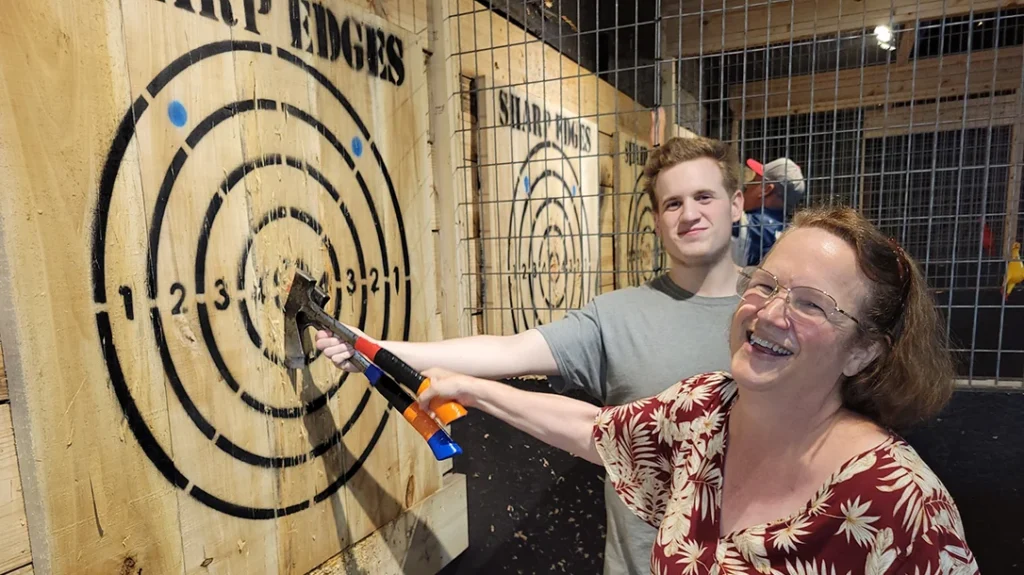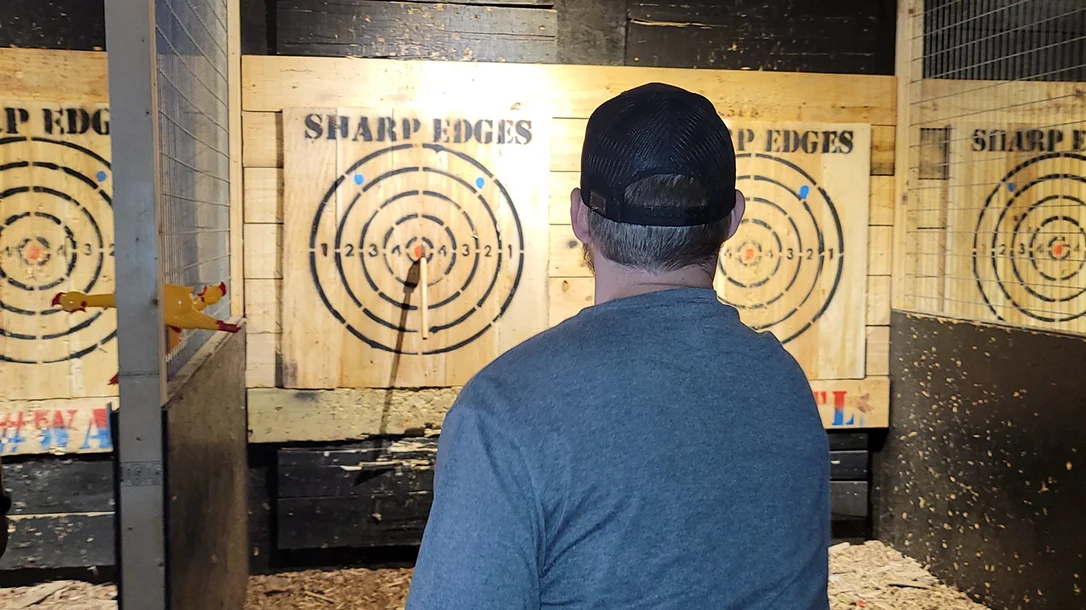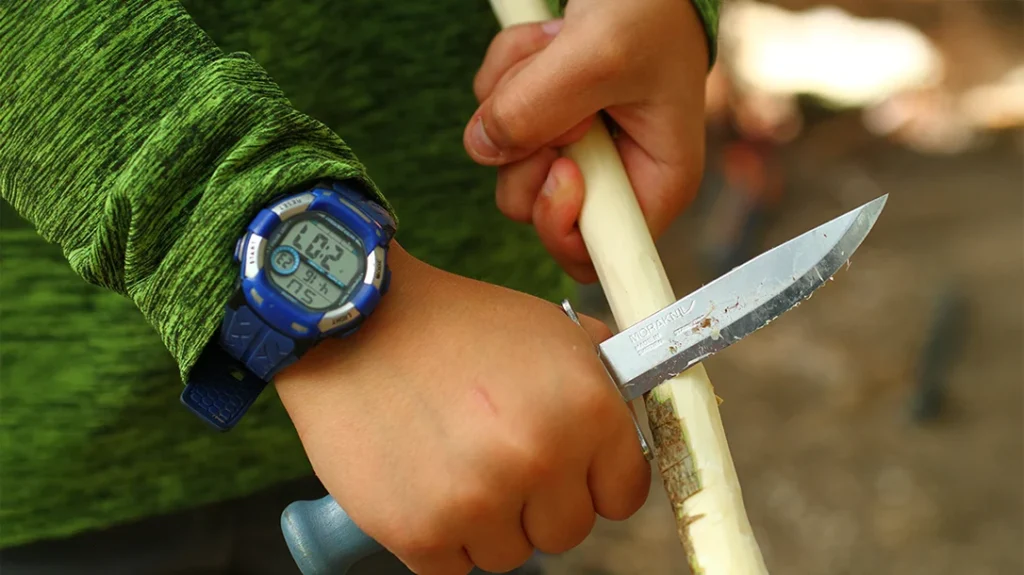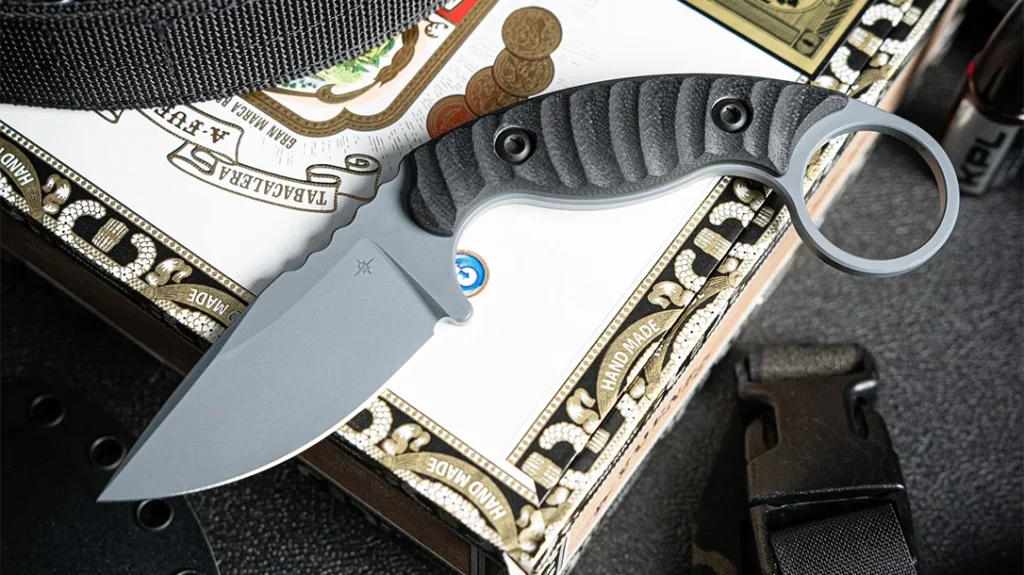Thunk. Another well-thrown axe found home in the five-ring of the cottonwood target. It was a rich and satisfying sound. An experienced thrower can tell without looking if he got a solid landing from the honed blades of the axes and knives that are slicing through the air at Sharp Edges Axe Throwing in Mountain Home, Arkansas.
Axe Throwing for Sport and Leisure
“Great throwers come in all shapes and sizes,” explained Mary Jo Haworth, Co-owner and manager of Sharp Edges. “It’s all about using the balance of the axe and your arm to make a revolution and land the blade in the target.”
With a bit of coaching, most people get a blade to stick in three throws or less after a few minutes of training. That initial success is confidence-building. Unfortunately, I am not most people. As a klutz, it took about eight tries for my first ax to land. But watching that blade bite into the target and stay put was addictive.
Advertisement — Continue Reading Below
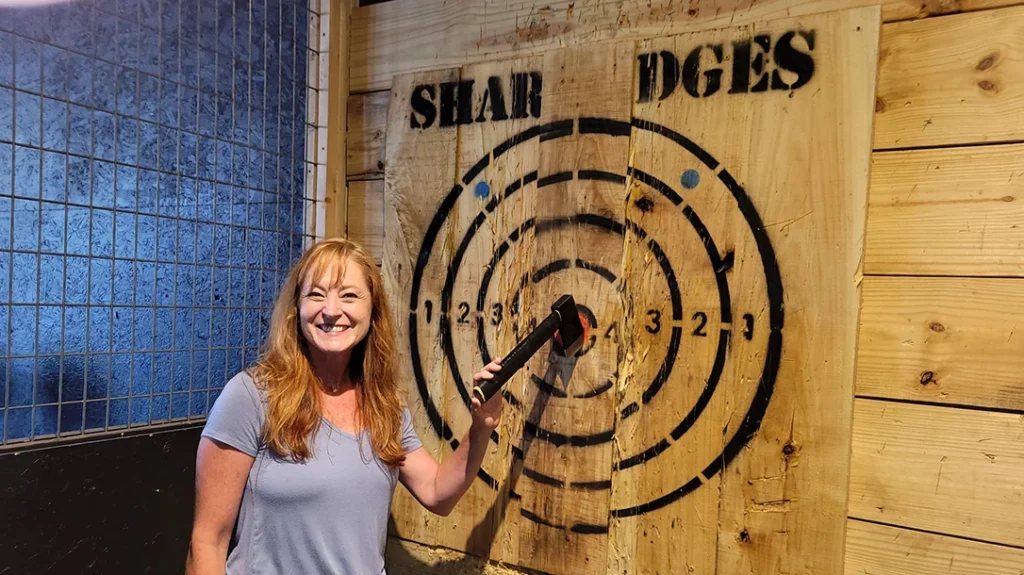
“Tiny women frequently beat muscled-up men when throwing the axes,” M.J. continued. “Women really seem to enjoy the sport. 60% of customers at axe-throwing businesses are women.”
In The Beginning
Native Americans had axes, but didn’t throw them in war or for fun. A well-balanced tomahawk was too valuable. For hundreds of years, axe throwing was a sport confined to mountain men and lumberjacks.
Advertisement — Continue Reading Below
In the 1940s, two-handed axe-throwing competitions started showing up at county fairs and other outdoor events. However, it was probably the Stihl Timbersports Competitions in the 1980s that began the era of modern axe throwing.
Axe leagues started in Canada in axe entrepreneur Matt Wilson’s backyard. However, the noisy competitions quickly outgrew the neighbors’ tolerance. The first commercial axe-throwing started at a bar in Toronto, Canada, in 2006. It was an after-work location to relax, sip a few, and fling axes at wooden targets.
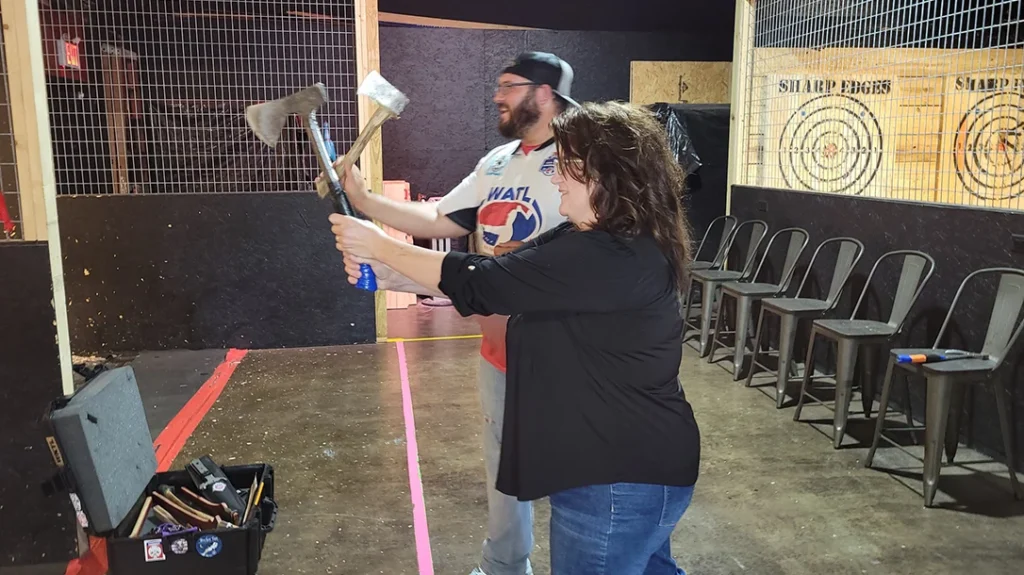
Advertisement — Continue Reading Below
Soon, informal and then formal rules and regulations were adopted. Before long, competitions began, and leagues and tournaments popped up near throwing centers.
Americans visiting Canada enjoyed blade sports at the ever-expanding axe-throwing businesses. Shortly after, Americans started opening their own axe-throwing locations.
A Quiet but Steady Growth
Like pickleball and disc golf, axe throwing expanded almost unnoticed through the Northern United States. Arguably, the first American indoor facilities opened in 2017 in Chicago and Philadelphia. After a few years, empty strip mall storefronts were converted to axe-throwing businesses in Northern towns and cities. Likely, they were hungry for something to do when snow and ice made outdoor sports difficult.
Advertisement — Continue Reading Below
Gradually, the sport trickled down from the North. There was a slowdown in growth during the COVID years. But today, almost all larger towns and cities have an axe-throwing range, and many metro areas have several.
Most people who come to axe-throwing establishments are total novices who saw a sign and thought it might be fun. However, an increasing number of people, such as Gary Palmer, look for axe-throwing businesses when traveling. They often bring along friends.

Advertisement — Continue Reading Below
Nicki Cleveland joined him on a recent Friday for her first try at throwing edged blades. She was good. In time, regular customers join leagues, and there are challenges between stores. Likewise, regional tournaments give the better throwers a chance to compete at higher levels.
The highest level of competition is the International Axe Throwing Championship. The finals were held on June 11th and broadcast on ESPN. There are two governing bodies for throwing sports, the World Axe Throwing League and The International Axe Throwing Federation.
Yes. You Throw Very Real, Very Sharp Axes
Her first axe throw, Sarah Auten’s axe bit deep into the center of the target. Sarah landed the first hatchet she ever threw in the five-ring. She tried throwing one-handed, the blade again landed almost perfectly. Then, she tried underhanded with another five-point shot. I envied her natural skill after my poor performance with two-handed throwing. Sarah is a natural.
Advertisement — Continue Reading Below
“Throwing like that happens all the time at Sharp Edges,” M.J. said. “People come in with no previous athletic training or axe throwing experience and nail it the first time they throw. Give me a second, I want to see if she is interested in joining the league we are forming.”
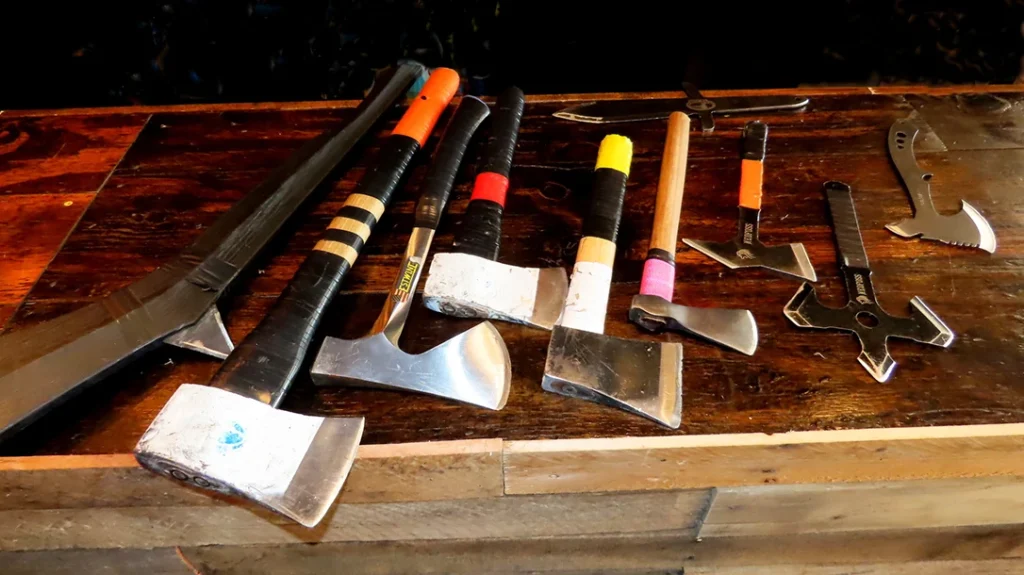
Sharp Edges has eight lanes, each set up for two throwers, and throwing axes are provided. For an event, party, or business team-building seminar, they can accommodate up to 50 throwers. Likewise, they have a mobile unit that is used at fairs and other outdoor gatherings.
The cost of throwing is $20 an hour, and they have frequent Broke Axe nights where throwing is half-price. This is similar to most axe-throwing locations across the country.
Methods of Throwing the Axe
Double-handed overhead throws are the way most beginners start out. The second line in the box is 12 feet from the target. This is the perfect step for the axe to make a complete rotation before hitting the target.
Align the center of your body with the bullseye, plant feet firmly, center both arms behind your head, take a step forward, and throw with the blade pointing up. Hold the axe like a hammer, fling your arms forward, and release the axe when your arms are pointing at the five ring. For most throwers, the axe will stick.
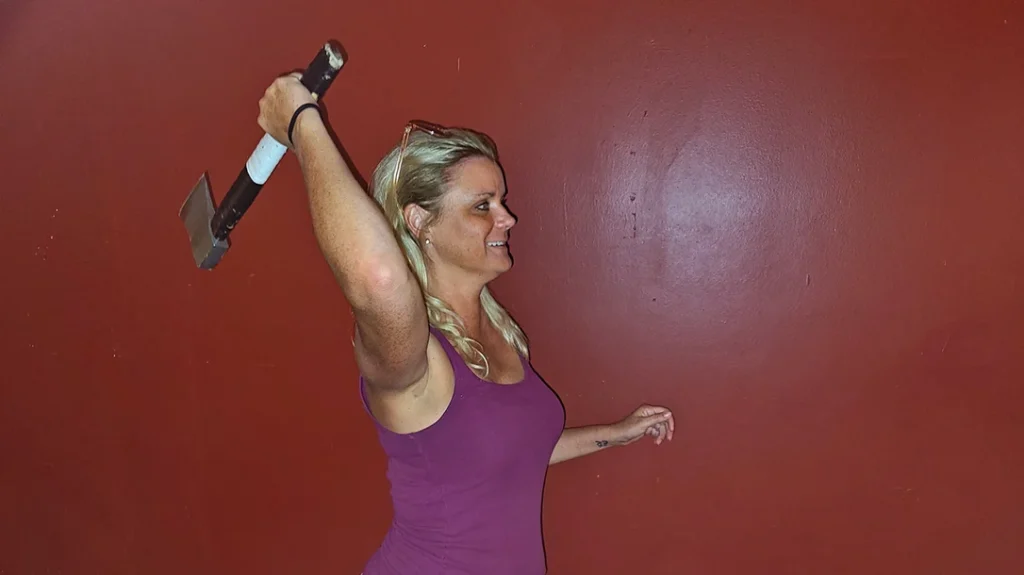
There are also single-handed and underhanded throwing positions. After a few throws, you will start noticing other throwers and learn from their movements. Often, they will make friendly suggestions. Skill happens quickly.
It doesn’t take long for most people to get competitive and start challenging a throwing partner or other folks in nearby lanes. The challenges are fun, and everyone wants the other throwers to succeed.
Getting Serious
As skill levels progress, throwers start buying or having specially balanced axes built. There are also other knives and edged blades available to experienced throwers, including a particularly wicked-looking Gun Stock War Club.
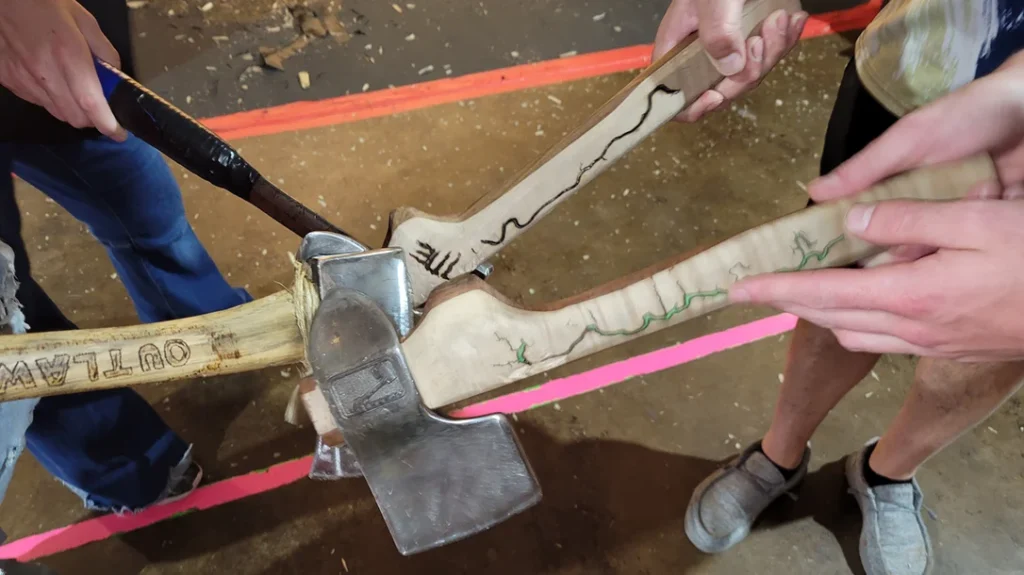
“It’s fun to throw odd blades,” said Jacob Leppold, an experienced thrower. “The War Club is different to throw because its balance is lower. Machetes are also a challenge because of the curve, and the weight is unbalanced. A good thrower can find many ways to build skills.”
There are a thousand reasons to throw axes. Here are a few:
- It is historic
- People are friendly and want to help
- The competitions build camaraderie and encourage working together
- It’s a great upper-body workout
- You meet people of all ages and from all walks of life
However, the best reason is the satisfying sound of a well-thrown axe quivering in a target.
Becoming a Pro Axe Thrower
The path to the top isn’t easy. Just ask Jimmy Grindle. Jimmy has been throwing axes for a year and a half and competing on the WATL tournament circuit for about a year. Unfortunately, the Midwest doesn’t have enough competitions to let throwers fill up their weekends and qualify for national ranking. This means, as a relatively new thrower, he has to travel long distances.
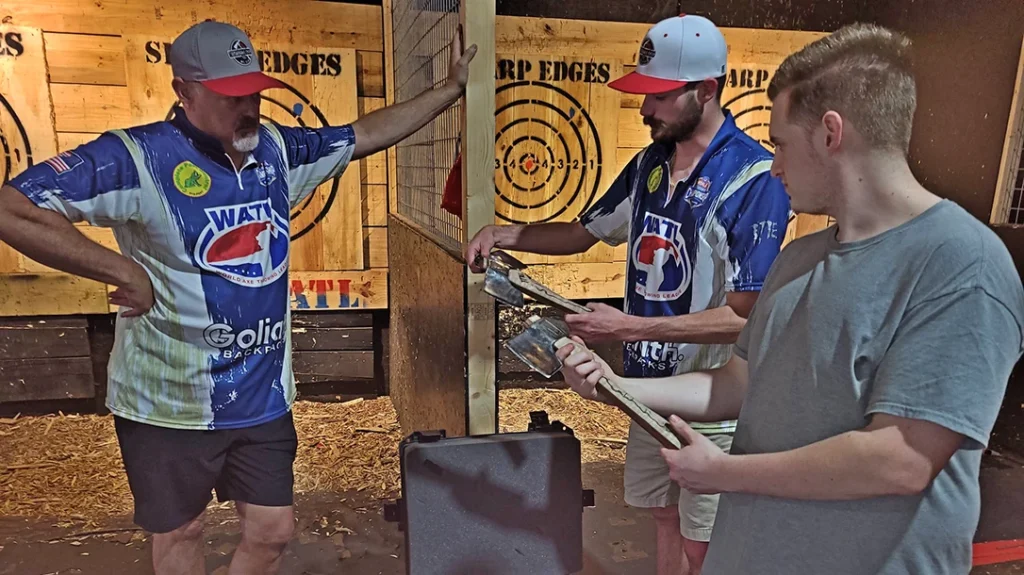
“Making it into the money rounds isn’t easy, so most of us need sponsors,” Jimmy said. “I’m very grateful to Toby’s Land Clearing, who supports my quest. The companies on thrower’s shirts help pay for gas and rooms going to tournaments. But unfortunately for me, the big-money sponsors support the highly-ranked players.”
It’s expensive to travel to places like Fargo, North Dakota. So, Jim and many other throwers share rides and rooms.
“Throwers are some of the best people I know,” Jimmy continued. “Not only do we travel together and share expenses, but a lot of each trip is spent planning throwing strategy, and giving tips on improving throwing form. Things like breathing, motions, and balance are discussed and dissected for each of us. The camaraderie on these trips is unbelievable.”
Competition Axe Throwing
Two spinning axes exploded from precisely coordinated hands in perfect symmetry. The blades lodged together millimeters apart in the bullseye of the target. Watching Mike Moss throwing with his Duals partner and son, Andrew, was like beautiful music—near-perfect symmetry. These are two guys at the top of the game.

Champion axe throwers don’t just come from Canada or the far North. Mike, owner of Tomahawk Chop Axe Throwing in Batesville, Arkansas, is classed as one of the top ten-ranked throwers in WATL. He competes nationally and has a shirt full of sponsors. At these elite levels of competition, winning first place isn’t just a mantle trophy. It’s a high finish that can be worth thousands of dollars.
“Everybody has gotten really good at honing their skills even while WATL has made competition throwing more challenging,” Mike said. “As an older thrower, I am different. But each of my competitors from the youngest on up genuinely wishes me well, and they come and cheer me on when I am competing.
“Competition is lively, fun to watch, and intense. At every level of the sport, from an individual’s first throw to the most elite throwers at tournaments, everyone wants you to succeed and be as good as possible. It’s a sport where everyone wins,” he concluded.
